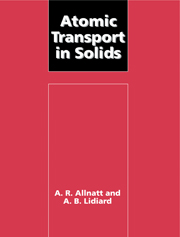Book contents
- Frontmatter
- Contents
- Preface
- List of principal symbols
- 1 Atomic movements in solids – phenomenological equations
- 2 Imperfections in solids
- 3 Statistical thermodynamics of crystals containing point defects
- 4 Non-equilibrium thermodynamics of atomic transport processes in solids
- 5 Some applications of non-equilibrium thermodynamics to solids
- 6 Microscopic theories – the master equation
- 7 Kinetic theory of relaxation processes
- 8 Kinetic theory of isothermal diffusion processes
- 9 The theory of random walks
- 10 Random-walk theories of atomic diffusion
- 11 Transport coefficients of dilute solid solutions – results and applications
- 12 The evaluation of nuclear magnetic relaxation rates
- 13 Theories of concentrated and highly defective systems
- References
- Index
12 - The evaluation of nuclear magnetic relaxation rates
Published online by Cambridge University Press: 28 December 2009
- Frontmatter
- Contents
- Preface
- List of principal symbols
- 1 Atomic movements in solids – phenomenological equations
- 2 Imperfections in solids
- 3 Statistical thermodynamics of crystals containing point defects
- 4 Non-equilibrium thermodynamics of atomic transport processes in solids
- 5 Some applications of non-equilibrium thermodynamics to solids
- 6 Microscopic theories – the master equation
- 7 Kinetic theory of relaxation processes
- 8 Kinetic theory of isothermal diffusion processes
- 9 The theory of random walks
- 10 Random-walk theories of atomic diffusion
- 11 Transport coefficients of dilute solid solutions – results and applications
- 12 The evaluation of nuclear magnetic relaxation rates
- 13 Theories of concentrated and highly defective systems
- References
- Index
Summary
Introduction
In the previous chapter we considered the evaluation of the macroscopic transport coefficients for models of substances displaying small degrees of disorder. In this chapter we turn to the evaluation of the effects of atomic movements upon the relaxation processes arising in nuclear magnetic resonance, as defined in §1.7 in Chapter 1. Our reason for devoting a whole chapter to this subject is that nuclear magnetic relaxation is the most widely applicable nuclear technique for studying atomic migration in solids after the direct application of radioactive tracers. Furthermore, it is still extending in various new directions, most notably for our purposes by the use of nuclear methods of alignment and detection with unstable nuclei, especially β-emitters (see e.g. Ackermann, Heitjans and Stöckmann (1983), Heitjans (1986) and Heitjans, Faber and Schirmer (1991)).
Except for self-diffusion coefficients determined by pulsed field gradient methods, the task which this subject presents to theory is rather different from that tackled in the previous chapter and it presents different mathematical problems, some of which derive from the need to deal with a two-particle correlation function (cf. (1.7.4)), while others derive from the nature of the physical interaction between the particles. For the most part the interaction we are concerned with is the nuclear magnetic dipole–dipole interaction, since this is always present (so long as the nuclear spin I > 0, i.e. so long as n.m.r. is possible). We shall also give some attention to the interaction between internal electric-field gradients and nuclear electric-quadrupole moments (I > 1/2). The dependence of these interactions upon relative position and orientation introduces mathematical complications, …
- Type
- Chapter
- Information
- Atomic Transport in Solids , pp. 460 - 504Publisher: Cambridge University PressPrint publication year: 1993



